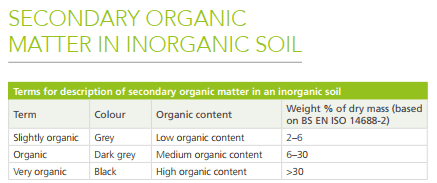This is when modified Burmister comes in handy. I know it's not used nearly as much as USCS, but it has its advantages.
and = 35%-50%
some = 20%-35%
little = 10%-20%
trace = 0%-10%
trace, little, or some (+) = on the higher end of trace, little, or some.
trace, little, or some (-) = on the lower end of trace, little, or some.
UCSC does allow for use of estimated percentages, which conflict with Burmister, and I have rarely seen used in practice but are included in ASTM D2488:
Trace—Particles are present but estimated to be less than 5 %
Few—5 to 10 %
Little—15 to 25 %
Some—30 to 45 %
Mostly—50 to 100 %
In all of the examples provided in ASTM, they provide approximate percentages in the sub description, which I have rarely seen used as well:
Silty Sand with Organic Fines (SM)—About 75 % fine to coarse, hard, subangular reddish sand; about 25 % organic and silty dark brown nonplastic fines with no dry strength and slow dilatancy; wet; maximum size, coarse sand; weak reaction with HCl.

